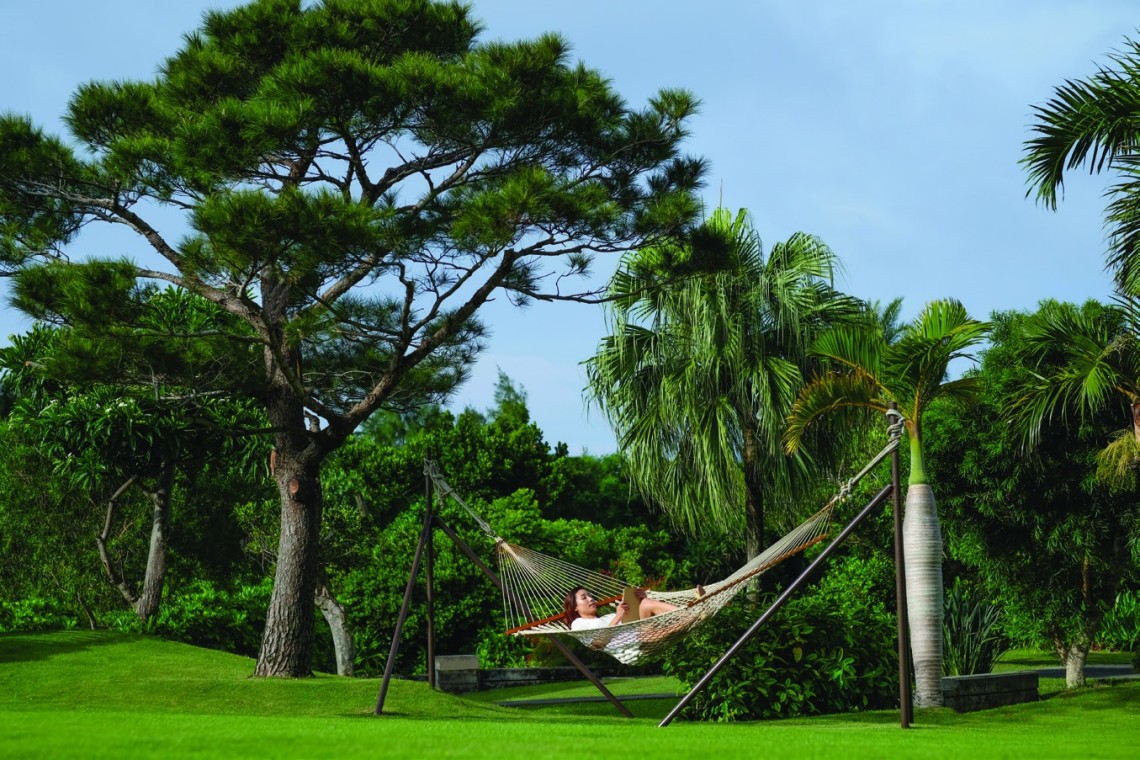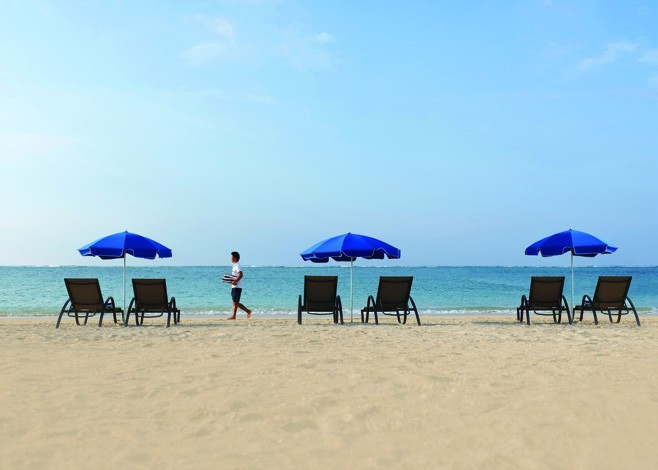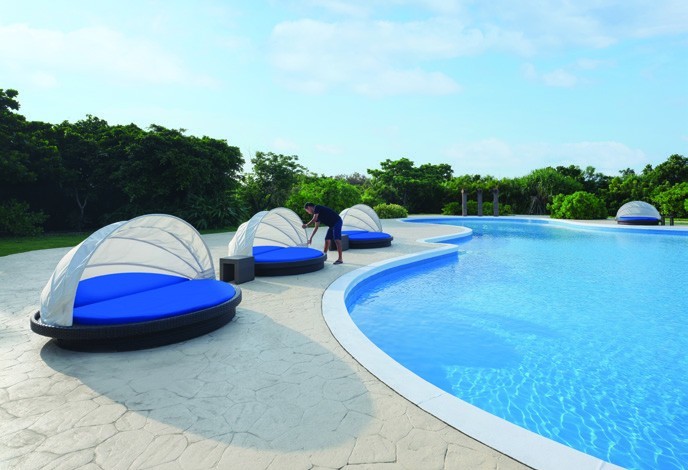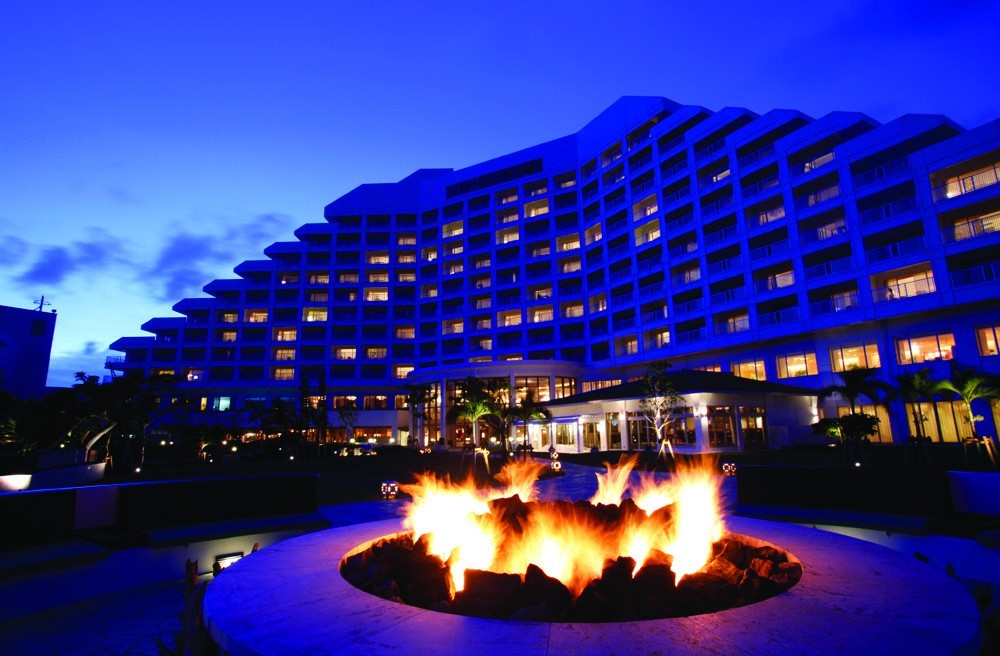The InterContinental-ANA Ishigaki Resort presents laidback, luxury living in beguiling lands that time almost forgot. Writer Elle Kwan Place


The plane offers us our first view of the islands at a right angle. Gazing through the oval window feels like glimpsing a box of twinkling jewels. Blue zircon and aquamarine seas sparkle, surrounding jade fields and emerald jungle. We flip. Now cotton ball clouds float in a turquoise sky.
HOW IS THIS JAPAN?
Sure, Tokyo and Osaka can be dazzling, flashing electronic signs a constant backdrop. But here in the Yaeyama Islands, kaleidoscopic views are natural and disappear each day following heart-melting syrupy sunsets into thick, silent black.
We land with a gentle bump on a tiny airport. This is Ishigaki, the first port of call for those exploring the Yaeyama Islands and a proud tropical getaway in its own right. The archipelago contains Japan’s southernmost and westernmost inhabited islands. This is as far as you can get from Japan’s main islands and the difference is palpable. Once out of the airport’s pocket office-sized arrivals hall, we wind our way through narrow roads divided by tall sugarcane, just one of Ishigaki’s many cultural treasures. The brown sugar it produces is prized for its high mineral content and during our stay we would find it packaged and portable as candy, syrup, cubes, jagged crystals, in cookies and desserts and ice cream.
There’s not a Hello Kitty in sight. Instead, you’re more likely to spot Shisa, mythical half lion half dogs employed, despite their wide-eyed cuteness, to ward off evil spirits.They stand to attention in pairs at gateways and porches, and two bronzed creatures welcomed us at the entrace of the InterContinental-Ana Ishigaki Resort Hotel, our home for the next four nights.
Now accessible via frequent flights from Hong Kong and Taiwan, and 60 minutes from Okinawa’s Naha airport, foreigners are beginning to sample this hidden gem that the Japanese have quietly savoured for years. The sprawling hotel rises like a white pyramid from the fields of cane and has everything anyone would need to unwind and enjoy a slice of island life.
WELCOME TO WELLNESS
From the lobby, multi-level glass windows afford views over manicured grounds, dotted here and there with hammocks and cushions. Each stylish room overlooks the same soothing views and is an immediate cushion of comfort. Daytime action takes place mostly around an indoor and outdoor pool with slide, and beyond that, Maesato beach, where wispy sea foam brushes the sandy stretch of coastline and the sea is as clear as glass. You can take snorkel trips out over the coral, or a take an underwater sea walk from this point too.
Eating here is wellness itself. Okinawans are famously proud of a heritage distinct from the rest of Japan. One of explorer and bestselling author Dan Buettner’s five “blue zones”, where inhabitants live the longest, healthiest lives, Okinawa has been called “land of the immortals,” for its lifestyle that mixes a strong sense of purpose, or ikigai, with a tight community, sun (and therefore vitamin D exposure), a plant-based diet and active lifestyle. There’s no doubt a stay at the hotel promotes an itinerary that captures most of these elements. Spend your days wandering the natural landscape and boosting a sense of gratitude for these unspoilt wonders, and then let your taste buds roam the varied regional and seasonal flavours.
“They look different than the Japanese, they live different from the Japanese,” says Jean Barcelo, of the native islanders, over dinner on our first night. Originally from Montreal, Jean-san, as he is affectionately known, has called Ishigaki home for 20 years, making him an ideal chief concierge. Local vegetables that night were served tempura style, seasoned with hibiscus sea salt as part of the Ishigaki set at Yaeyama, the hotel’s casual eatery. Lacelike batter coated okra and locally grown goya, or bitter gourd. It was feather light and crunch crisp. How? “Some say you need to keep the batter extra cold,” Jean-san said, his blue eyes twinkling. Theirs was a house recipe, and he wasn’t giving much else away.
You’ll also find a sharp local ginger beer on the menu, a tea of local herbs, seasonal regional fish, raw and seared. Local-made tofu is served in a traditional Okinawan breakfast set. And who’d have guessed that loofah—yes, more commonly known as a stiff piece of skin-slathering bathing apparatus—would have charmed the senses hot off the Teppanyaki grill? This could have to do with a melted butter accompaniment (what isn’t elevated with butter?) or the nimble-fingered skill of our personal chef who perfected his hot-grilling over a 20 year career at the hotel. (So long, he tells us with a grin, while he flips fish on the sizzling grill, that he remembers it as the Sun Coast, long before IHG waved its wand over the property and turned it into an InterContinental.) Loofah is related to the cucumber and warm mouthfuls tasted fresh, plantlike and bursting with goodness.
This culinary wonder was soon overshadowed in a feast of gluttony, as whopping hunks of local Ishigaki beef was served with local Okinawan beef. (Raised in similar areas, from different breeds, to a different set of standards). Playing “Which is your favourite?” was the evening’s natural sport and results fell between those that like fattier, marbled cuts (Okinawan) versus those who prefer leaner meat with a tad more chew (Ishigaki), although to be fair comparing velvety bites is like comparing diamonds to gold. Smitten, we also sampled beef as shabu-shabu and sukiyaki at two other on-site restaurants –– though, blessedly, not on the same night.
Salt. Sugar. Bitter gourd. Tofu. Sweet potato. Fruits. Indigenous plants and herbs. Regional varieties of miso and noodles, beer and Awamori. Even coffee. Local food is prized in Ishigaki and you’ll find these ingredients in tea, wellness shakes, as jams and preserves, as well as enjoyed on their own. If you think you’ve tried mango or pineapple, rest assured you haven’t until you savour it in season at somewhere like Hikari Rakuen, an unassuming shack set on unblemished farmland, where a steady cluster of visitors waiting in line speaks to its popularity. This mango tastes like a mango really should: summer. As in soft, round and sweet, with notes of vanilla and shea butter, not unlike good sun lotion smells. If you visit the Yuratiku Ichiba market at the right time, the plump fruits are wheeled out on carts, as white-clad grocers ring bells and holler prices. Mango, it seems, is to Yuratiku Ichiba what tuna is to Tokyo’s Tsukiji.
The area’s natural surrounds are just as pure, unadulterated and unique. Waters are crystal wherever you venture, even at the ferry port, where boats shunt to remote Iriomote, the area’s deep jungle last frontier, or nearby Taketomi island. Once there, catch a cart pulled by a water buffalo and trample sands made from stars. Truly. Grains are the star-shaped shells of amoeboids foraminifera and are a whole lot more romantic than it sounds. (Bring a bag, but take only a thimbleful to treasure). Back on Ishigaki’s westernmost cape, the sun glints off the sea at the Uganzaki Lighthouse and gorgeous sunsets were made to Instagram.






PROUD HERITAGE
What the hotel does so brilliantly is weave together this national reverence for culture, health and well-being. There’s a palpable and celebrated sense of place. At night, a fire pit is lit and guests assemble before the burning embers to take a star-spotting tour because, you know, no light pollution. It’s beguiling. At 6am, scuttling hermit crabs are the only other noticeable living creatures on Maesato beach, where a handful of us assemble for morning yoga. We hatha bend and stretch in tune to the waves as a gentle wind lifts the heat off the rising sun. Our sun salutations feel pure and untarnished.
At Spa Agarosa, pale, modern decor subtly mimics the calming beach vibe. Spa Manager Kaori Okumura, explains how she replaced French luxury skincare with local brands and ingredients. The change began when she brought in the Ruhaku line, which uses gettou, known as shell ginger, whose fragrant leaves Okinawans use to wrap rice cakes or boil into medicinal teas. (Thick, spiky bushels of it also grow on the hotel’s grounds).
Spa visitors loved the gettou-focused treatments. Okumura kept them and continued hunting for produce more specific to Ishigaki. Eventually, she found it in euglena, a microscopic algae farmed locally and rich in 59 different nutrients. Its healing energy comes from a photosynthetic process, and is used in health supplements, shakes and cookies, as well as the delicately scented B.C.A.D products at the spa. In the future, Euglena Co. who produces it, and has become one of Japan’s most successful start-ups, plans on using the euglena to fuel planes.
We tried it in a heavenly top-to-toe treatment. First local Ishigaki salt was used in a relaxing footbath, followed by a B.C.A.D facial and an all-over massage using the brand’s treatment oil. Light and softening, the products have an uplifting and vaguely menthol fragrance that left us wonderfully at peace and in tune with our surroundings. Dinner at the Fireside Terrace featured a euglena-rich menu, adding to the sense of total wellness. Like kale or green tea, the health-giving algae has a slightly bitter taste, and we enjoyed it as a green smoothie to begin, in the form of grissini sticks and baked into bread, and spiralised as cold noodle, with more local delicacies, including a few more hunks of that addictive beef. It was a perfect last-night salute to Ishigaki and all of its natural riches.
Ishigaki is delightfully a place on pause. Not quite the land that time forgot, but a land that remains rightfully rapturous of its cultural identity. Four days flew by. We couldn’t have packed more into our schedule, but we still missed canoeing the mangroves, visits to Awamori distilleries, snorkeling and more. We got a big bite of the pie but it feels like there’s plenty more to taste in this island hideaway. What better invitation for a return visit? www.ihg.com


























